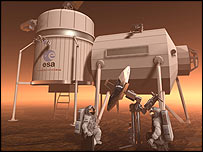A laser facility that will be launched in 2009 will transmit information to the earth at a rate of 30 megabits per second. The high transmission rate will be possible thanks to the use of infrared laser radiation with a length of 1.06 micrometers, a much smaller wavelength than radio radiation, which is the radiation currently used to transmit information from distant spacecraft.
Yoram Ored, Galileo Magazine

Direct link to this page: https://www.hayadan.org.il/marslaser0305.html
The spectacular, rich and clear images we receive every day from spacecraft located on or near the surface of distant celestial bodies are evidence of the great progress of photography and space communication technology over the past decades. However, a very limiting factor to our ability to deal with the problem of transmitting these images to Earth is the rate of information transmission through the spacecraft's transmitters.
The highest rate reached so far by spacecraft in data transmission is 128 kilobits per second, which represents the transmission rate transmitted by the Mars Odyssey spacecraft. Many images are collected by Mars spacecraft using their sophisticated cameras, but due to the limited transmission rate, almost all of them do not get to reach Earth.
What might help deal with the transmission rate problem is a laser device that would be launched towards the Red Planet and transmit images from it or its surroundings at a much faster rate. Beyond that - the facility will be less massive than the broadcasting facilities currently accepted for broadcasting images from Mars and will also consume less power. The facility is planned to be sent by NASA in 2009.
The laser facility will send information at a rate of up to 30 megabits per second, tens of times the highest transmission rate recorded so far. The high transmission rate will be possible thanks to the use of infrared laser radiation with a length of 1.06 micrometers, a much smaller wavelength than radio radiation, which is the radiation currently used to transmit information from distant spacecraft.
The speed of all electromagnetic radiation in space is the same - approximately 300,000 kilometers per second. Therefore, compressing more information in a given time is possible using radiation with a smaller wavelength. Since the wavelength of infrared laser radiation is much smaller than that of radio radiation, it enables the transmission of information at a greater rate.
The idea of the infrared laser device looks promising, but it is not without its drawbacks. One of them is that clouds may block the radiation coming from it to the earth, while radio radiation easily penetrates through them. Another disadvantage is that the laser beam reaching the Earth will be much narrower than radio beams transmitting information coming from spaceships from the depths of space: the width of such a radio beam upon reaching the Earth is so wide that it "covers" the whole.
A laser beam, on the other hand, due to its very low dispersion, will reach a width of several hundreds of kilometers, which will require precision in the direction of the beam to its reception point on the surface of the earth in order to receive the information it carries with it. To deal with these two problems, NASA intends to use several points on the Earth's surface to receive the beam.
In this way, if the sky above one of them is covered with clouds that prevent the beam from penetrating through them, it will be possible to receive the beam at an alternative reception point, which will still be within the beam's range. The problem of the need for precision in receiving the beam will also be solved in this way because if the beam misses one reception point, it will be possible to receive it at another reception point.
The infrared laser beam will be transmitted from a spacecraft in orbit around Mars and when it reaches the Earth, its power will be much lower than that of radio beams that reach the Earth from spacecraft located on Mars or in its vicinity. To deal with the expected low intensity of the beam, NASA is developing detectors that will be several orders of magnitude more sensitive than the detectors currently used to receive space radio beams.
The laser-carrying spacecraft that will attack Mars will also be equipped with conventional radio transmitters. It must be assumed that the planned laser is not the end of the story in the field of data transmission rate from deep space. Future transmission rates using more sophisticated laser transmitters will surely increase.
Spacecraft expert - the next generation
Ydan Mars
https://www.hayadan.org.il/BuildaGate4/general2/data_card.php?Cat=~~~92430827~~~8&SiteName=hayadan
